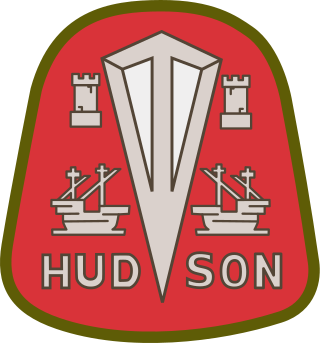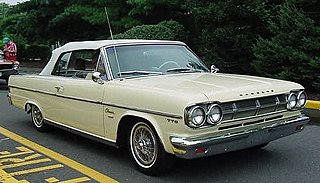Related Research Articles

American Motors Corporation was an American automobile manufacturing company formed by the merger of Nash-Kelvinator Corporation and Hudson Motor Car Company on May 1, 1954. At the time, it was the largest corporate merger in U.S. history.

Nash Motors Company was an American automobile manufacturer based in Kenosha, Wisconsin from 1916 until 1937. From 1937 through 1954, Nash Motors was the automotive division of Nash-Kelvinator. As sales of smaller firms declined after 1950 in the wake of the domestic Big Three automakers’ advantages in production, distribution, and revenue, Nash merged with Hudson Motors to form American Motors Corporation (AMC). Nash automobile production continued from 1954 through 1957 under AMC.

The Hudson Motor Car Company made Hudson and other branded automobiles in Detroit, Michigan, U.S., from 1909 until 1954. In 1954, Hudson merged with Nash-Kelvinator to form American Motors Corporation (AMC). The Hudson name was continued through the 1957 model year, after which it was discontinued.

The initial design development for the PowerTech V6 and V8 engine family was done by American Motors Corporation (AMC) and debuted in 1998 with credit to Chrysler. This was the first new V8 engine for Chrysler since the 1960s. The companion V6 was basically the V8 with two fewer cylinders, another concept that originated at AMC before the company joined Chrysler. These new engines had nothing in common with the Chrysler A engine V8s, nor the Jeep 4.0 L "PowerTech" I6 engine.

The Iron Duke engine is a 151 cu in (2.5 L) straight-4 piston engine built by the Pontiac Motor Division of General Motors from 1977 until 1993. Originally developed as Pontiac's new economy car engine, it was used in a wide variety of vehicles across GM's lineup in the 1980s as well as supplied to American Motors Corporation (AMC). The engine was engineered for fuel efficiency, smooth operation, and long life, not for performance. Total Duke engine production is estimated to be between 3.8 and 4.2 million units.

The Ambassador is an automobile manufactured and marketed by American Motors Corporation (AMC) from 1957 through 1974 over eight generations, available in two- and four-door sedan, two-door hardtop, four-door station wagon as well as two-door convertible body styles. It was classified as a full-size car from 1957 through 1961, mid-size from 1962 until 1966, and again full-size from 1967 through 1974 model years.

The Buick V6 is an OHV V6 engine developed by the Buick division of General Motors and first introduced in 1962. The engine was originally 198 cu in (3.2 L) and was marketed as the Fireball engine. GM continued to develop and refine the 231 cu in (3.8 L) V6, eventually and commonly referred to simply as the 3800, through numerous iterations.

The Jeep Gladiator, Jeep Pickup or J-series is a series of full-size pickup trucks based on the large Jeep SJ (Wagoneer) platform, which was built and sold under numerous marques from 1962 until 1988. The Jeep Gladiator/Pickup design is noteworthy for remaining in production for more than 26 years on a single automobile platform generation. The Gladiator was the basis of the first post-war U.S. Army trucks designed to be civilian vehicles and adapted to military use. Numerous versions of the Jeep pickup were built in other markets, including Mexico by Vehículos Automotores Mexicanos (VAM) and Argentina by Industrias Kaiser Argentina (IKA).

The Pontiac straight-6 engine is a family of inline-six cylinder automobile engines produced by the Pontiac Division of General Motors Corporation in numerous versions beginning in 1926.

The AMC V8 may refer to either of two distinct OHV V8 engine designs developed and manufactured by American Motors Corporation (AMC) starting in 1956. These engines were used in cars and trucks by AMC, Kaiser, and International Harvester, as well as in marine and stationary applications. From 1956 through 1987, the automaker equipped its vehicles exclusively with AMC-designed V8 engines.

The AMC straight-6 engine is a family of straight-six engines that were produced by American Motors Corporation (AMC), and used in AMC passenger cars and Jeep vehicles from 1964 through 2006. Production continued after Chrysler acquired AMC in 1987.

The Jeepster Commando is an automobile which was first produced by Kaiser Jeep in 1966 to compete with the International Scout, Toyota Land Cruiser and Ford Bronco. Four different models were available: a pickup truck, convertible, roadster and wagon. The Jeepster remained in production after American Motors Corporation (AMC) bought the Jeep line from Kaiser in 1970. After AMC's acquisition, the Jeepster Commando C101 steadily grew in popularity. In 1972, AMC shortened the vehicle's name to Commando C104, extended the wheelbase to 104", and changed the front-end design to accept the AMC I6 and V8 304ci, similar to the Ford Bronco. The new configuration, formerly an AMC best seller, quickly caused the line to drop in popularity and was taken out of production in 1973; it was replaced with the full size Cherokee. The Jeepster is an ancestor of the modern Jeep family produced by Chrysler.

The Rambler American is a compact car that was manufactured by the American Motors Corporation (AMC) between 1958 and 1969. The American was the second incarnation of AMC forerunner Nash Motors' compact Rambler that was introduced in 1950 and marketed after the merger with Hudson Motors under both marques during the 1954 and 1955 model years.

The Rambler Classic is an intermediate-sized automobile built and marketed by American Motors Corporation (AMC) from the 1961 through 1966 model years. The Classic replaced the Rambler Six and Rambler Rebel V8 names, which were retired at the end of the 1960 model year.

The Rambler Rebel is an automobile that was produced by the American Motors Corporation (AMC) of Kenosha, Wisconsin for the 1957 through 1960 model years, as well as again for 1966 and 1967.

The Hudson Hornet is a full-size car manufactured by Hudson Motor Car Company of Detroit, Michigan from 1951 until 1954, when Nash-Kelvinator and Hudson merged to form American Motors Corporation (AMC). Hudson automobiles continued to be marketed under the Hudson brand name through the 1957 model year.
Vehicles made by American Motors Corporation (AMC) and Jeep incorporated a variety of transmissions and transfer case systems. This article covers transmissions used in the following vehicle models and years:

The Nash Rambler engine is a family of straight-six engines that were produced by Nash Motors and then American Motors Corporation (AMC), and used in Nash, Rambler, and AMC passenger cars from 1940 through 1965. It was succeeded by the AMC straight-6 engine in 1964, a completely new design. The engine evolved in several displacements and was built with two different valvetrains. The engine was originally of a flathead layout; an OHV version was introduced in 1956 although the flathead continued to be available. A version of the OHV engine with an aluminum block was introduced in 1961.
References
- ↑ "Mighty Mite M422". 4WD Online. Retrieved 26 January 2013.
- ↑ Dunne, Jim (January 1976). "Detroit Report". Popular Science. 208 (1): 24. Retrieved 26 January 2013.
- ↑ Dunne, Jim (October 1984). "AMC for '85". Popular Science. 225 (4): 87. Retrieved 26 January 2013.
- ↑ Dunne, Jim (July 1974). "Detroit Report". Popular Science. 205 (1): 22. Retrieved 26 January 2013.
- ↑ Ward's automotive yearbook - Volume 34. Ward's Reports. 1972. p. 146.
- ↑ Lund, Robert (October 1971). "AMC gets it together". Popular Mechanics. 136 (4): 118. Retrieved 26 January 2013.
- ↑ Sessler, Peter C. (2010). Ultimate American V-8 Engine Data Book (Second ed.). Motorbooks International. p. 228. ISBN 9780760336816 . Retrieved 19 January 2014.
